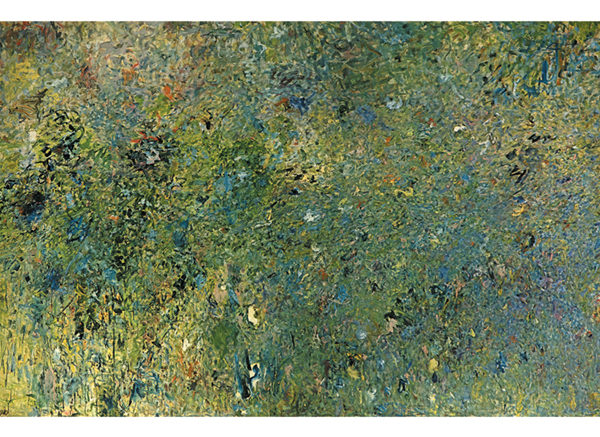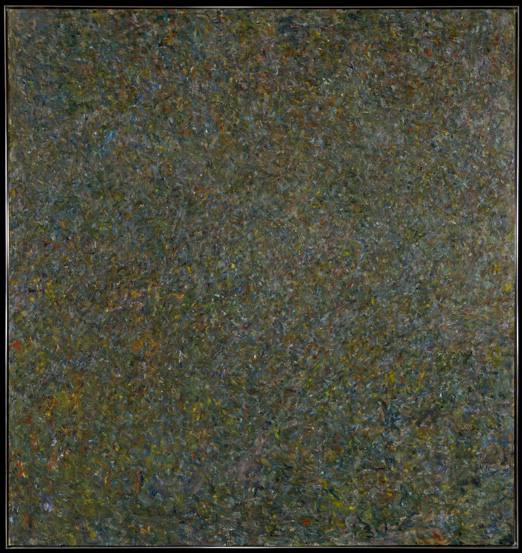I wanted to post something about Milton Resnick. Some years back, about five or so, I was at a small retrospective of Milton Resnick at Cheim and Read, the first of two. In the first large room were some giant earlier paintings by Resnick, done while he was still painting more in relation to de Kooning. Then in the next smaller room was a painting done in the 60’s entitled “Wedding”, maybe eight foot by eight foot, not small. I’ve posted it here. At first when I stood in front of that painting I thought it was a blue-green overall sort of thing. Then I noticed the myriad colors and the extraordinary density of the surface. As I continued to stand there, I started to notice that my state of mind was not normal. Something had shifted, the way it does when we stand in powerful wind and let it blow through us. Then I felt like I was standing in front of a waterfall. I felt stoned. I was overwhelmed and couldn’t walk away. I don’t know how Resnick did this. I know de Kooning spoke of the need to stay on an edge all of the time while painting. Resnick spoke not of an edge but of “falling”. Falling. What does it mean to fall? And what does it mean to fall while painting? The digital image doesn’t begin to get at any of this.
Sometimes I think that de Kooning was the greatest American painter of the twentieth century. I don’t think of Resnick that way. I think Resnick was a mystic.
Here is a quote from Resnick about “Mound” and the act of painting, from the book “Out of the Picture”:
“About three years went by and I had become exhausted — really at the end of my rope almost and I thought I couldn’t last much longer… and at the very end when I thought of giving it all up, suddenly I thought it was good. I knew that I now understood something about it and I painted it as easily as you can imagine. I just had no trouble painting it and it became a very important painting. I called it Mound — I don’t know why.
“With Mound, a new experience became very important to me and the reason that I felt that I should have known it from the first — when I said that I painted myself out — is that it was always there for me to see; that the way a picture works, it’s not so much how you put a picture together as how the picture puts you together…In fact I discovered something very important; that if you change paint from what it is, you destroy something very important about paint but more important than that is that you don’t change. As long as you can change paint, you don’t change. For you to change — for paint to do something to you — paint must stay constant. The act, the doing, the taking up of paint and putting it down — the immediate impact upon your psyche or soul that occurs when you do that — has so much danger in it. It’s such a magical important act in your life. Why it is so important and how it does act upon you has to be realized. You have to cope with it. You have to make a point of understanding that. Much more important than anything else about art is what happens when you do that, and what happens to you. And nobody, of course, talks about that.
“It’s absolutely irrelevant what galleries and critics and people who buy your paintings think. They just don’t have any possible idea of what happens to you and they’re really not that interested. As a matter of fact, they hate the idea that anything really happens to you. They want you to be a genius and that’s it. They don’t want anything to have happened; they want you to be born and be that special person with that brand on you — “genius,” and that’s it. You have to be wonderful and that’s all there is to it. Then, anything that you happen to do gets to be part of that wonderful thing that you are. But what is of a great deal of importance to you is what do you do when you paint? How does it change you? What does it make of you? Because you are certainly not the person who should be painting a painting. None of you are. None of us are. We cannot live without our place in the things and the place in which we live does not make room for painting. We are doing something contrary to our place and time and as long as we remain what we are all we can do is indicate our opinion. In other words, art becomes our opinion about ourselves, our times, our place; and that, of course, is not really painting.”
That really pretty much says it. But I want to add something that I think Resnick is speaking to — something that I find myself circling back to in my mind, over and over, and that is the power of form, the power of form to affect us. There’s a limit, of course. We have to participate. We have to be open to going there. Deeply. Still, there it is — the possibility of form to make an impact — to actually affect us. It seems like such an obvious and clear thing, but I have to confess that for most of my life I didn’t quite believe it. And so, if it’s true that my spirit and my heart responds to form, resonates and moves because of form — then what? What does that mean to me as a maker, as a form maker?

